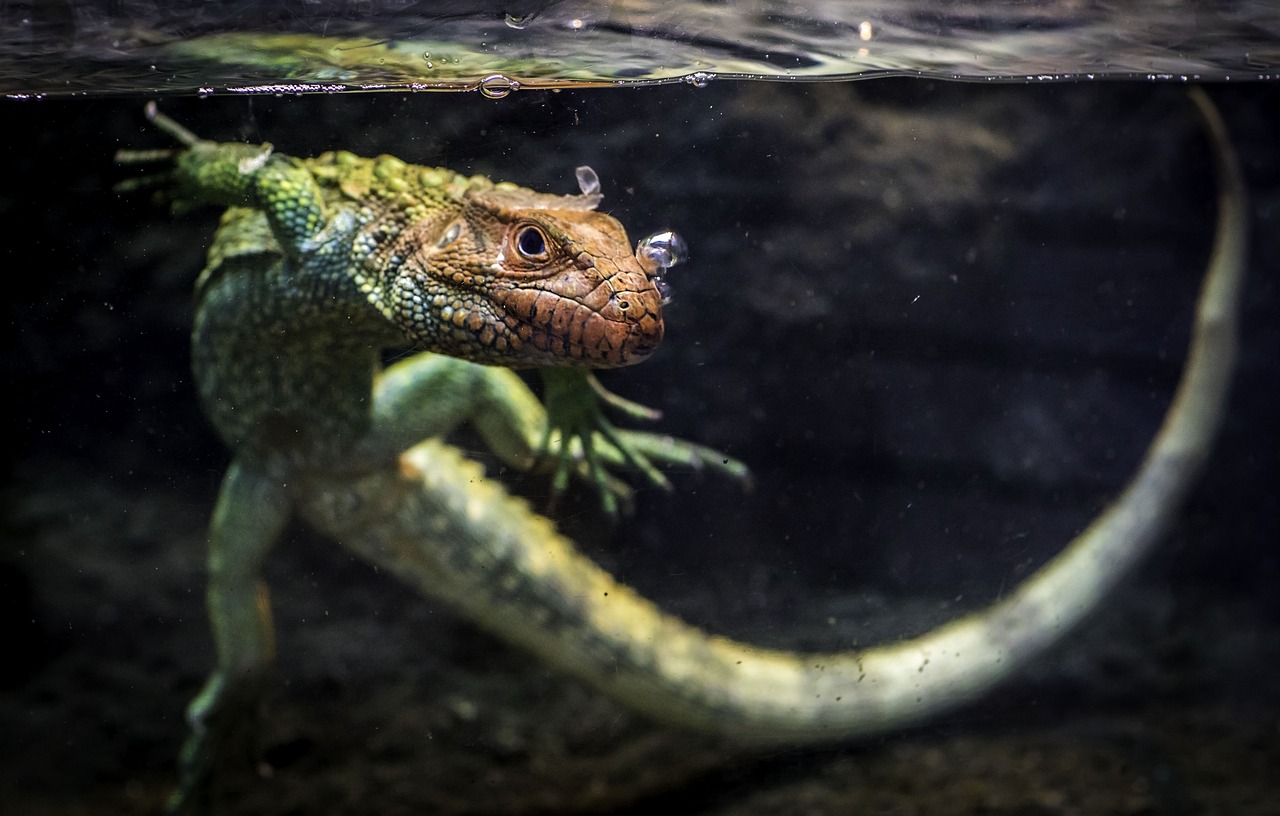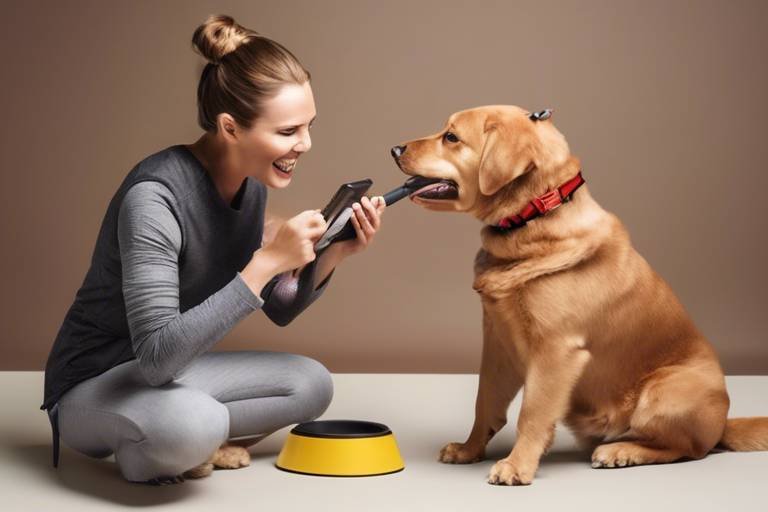How to Help Your Pet With Sensitivity to Touch
Sensitivity to touch can be a challenging issue for both pets and their owners. Imagine your furry friend flinching or backing away when you reach out to pet them; it can be heart-wrenching and confusing. As loving pet owners, we want nothing more than to provide comfort and affection, but sometimes our gestures can inadvertently cause distress. In this article, we will explore effective strategies and tips to support pets experiencing sensitivity to touch, ensuring their comfort and well-being while enhancing the bond between pet and owner.
Before we dive into solutions, it's essential to understand what sensitivity to touch means for our pets. This sensitivity can stem from various factors, including physical discomfort, emotional trauma, or behavioral quirks. For instance, a pet that has had a rough past may associate touch with negative experiences, leading to anxiety or fear. Additionally, certain medical conditions can make a pet more sensitive to touch, causing them to react strongly even to gentle petting. Recognizing the underlying reasons is the first step in helping your pet feel more at ease.
Identifying the signs of touch sensitivity in pets is crucial for effective intervention. You might notice your pet displaying specific behaviors that indicate discomfort when touched. For example, they might freeze in place, attempt to escape, or even growl. Understanding these signs can empower you to respond appropriately and provide the support your pet needs. The key is to observe your pet closely and learn their unique signals.
Pets may exhibit various behavioral changes when experiencing touch sensitivity. Some common indicators include:
- Flinching or twitching: A sudden movement away from your hand can signal discomfort.
- Hiding: If your pet frequently seeks out secluded spots, they may be trying to escape unwanted contact.
- Growling or snapping: These are clear signs that your pet feels threatened or uncomfortable.
By recognizing these behavioral indicators, you can take proactive steps to make your pet feel more secure and comfortable.
Understanding your pet's body language is essential. Look for key signals that suggest a pet is feeling sensitive or uncomfortable with touch. For instance, a tucked tail, flattened ears, or wide eyes can all indicate anxiety. Pay attention to how your pet's body shifts in response to your touch; a tense body often means they are not enjoying the interaction. Being attuned to these cues can greatly improve your ability to respond to your pet's needs effectively.
Pets may vocalize or react in certain ways when touched. Different sounds can indicate different feelings. For example:
- Whining: This can be a sign of discomfort or anxiety.
- Barking: Some pets may bark to express their distress.
- Growling: As mentioned earlier, this is a clear warning sign that your pet is not comfortable.
By paying attention to these vocalizations, you can better understand your pet's emotional state and adjust your interactions accordingly.
Emotional factors can significantly impact a pet's sensitivity to touch. Anxiety, fear, and past experiences can shape a pet's reactions. For example, a dog that was previously abused may flinch at the slightest touch, associating it with pain or fear. Understanding these emotional triggers is vital for creating a supportive environment. It’s important to approach your pet with patience and compassion, allowing them to set the pace for physical interaction.
A supportive environment can help alleviate touch sensitivity. This means creating spaces where your pet feels safe and secure. Consider setting up a cozy corner with their favorite blanket or toys, where they can retreat whenever they feel overwhelmed. A calm atmosphere can work wonders in reducing stress levels, making your pet feel more at ease with touch over time.
Designating areas where pets feel secure can reduce stress. Here are some tips on creating safe havens within your home for your sensitive pet:
- Choose quiet locations away from household traffic.
- Use soft bedding and familiar toys to make the space inviting.
- Limit access to noisy appliances or bustling areas during their relaxation time.
Creating these safe spaces can help your pet recharge and feel more comfortable when it’s time for physical interaction.
Employing comforting techniques can make a significant difference. Gentle handling methods, such as slow movements and soft strokes, can help ease your pet's discomfort with touch. Additionally, consider using calming practices like:
- Soft music or white noise to create a soothing atmosphere.
- Massage or gentle brushing to help them relax.
- Positive reinforcement, such as treats or praise, when they tolerate touch.
These techniques can help build trust and gradually reduce sensitivity over time.
Q: How can I tell if my pet is sensitive to touch?
A: Look for signs such as flinching, growling, or hiding when approached. Pay attention to their body language and vocalizations.
Q: What should I do if my pet reacts negatively to touch?
A: Give them space, observe their behavior, and try to identify any triggers. Gradually introduce touch in a calm environment.
Q: Can sensitivity to touch be related to medical issues?
A: Yes, certain medical conditions can cause sensitivity to touch. If you suspect this, consult your veterinarian for guidance.
Q: How long does it take for a pet to become comfortable with touch?
A: It varies by individual pet and their past experiences. Patience and consistency are key in helping them adjust.

Understanding Sensitivity to Touch
Sensitivity to touch in pets can be a perplexing issue for many pet owners. You might wonder, "Why does my furry friend flinch when I pet them?" Well, there are several underlying reasons that contribute to this sensitivity. It’s essential to understand that pets, just like humans, have their unique personalities and experiences that shape their reactions to touch. Some pets may have a history of trauma or negative experiences associated with being touched, while others may be naturally more sensitive due to their breed or individual temperament.
One significant factor that influences touch sensitivity is physical discomfort. Pets that are experiencing pain, whether from an injury or a chronic condition, may react negatively to touch. For example, a dog with arthritis might find it painful when you try to pet them in a certain area. Additionally, certain breeds are more prone to skin sensitivities or allergies, which can cause discomfort when touched. It’s crucial to observe your pet's behavior and consult a veterinarian if you suspect physical issues.
Another layer to consider is the emotional state of your pet. Just like us, pets can experience a range of emotions. Anxiety, fear, and stress can all heighten a pet's sensitivity to touch. For instance, a rescue dog that has faced neglect might be particularly wary of being touched, associating it with past trauma. This emotional sensitivity can manifest in various ways, including avoidance behaviors or even aggression when approached. Understanding these emotional triggers is key to helping your pet feel safe and secure.
Behavioral factors also play a role in touch sensitivity. Some pets might have learned to react negatively to touch due to past experiences or training methods that were too harsh. For example, if a cat was frequently scolded when picked up, it might develop a fear of being handled. This learned behavior can create a cycle of sensitivity that requires patience and understanding from the owner to break. It’s essential to approach your pet with empathy and to foster a trusting relationship.
In summary, sensitivity to touch in pets can stem from a complex interplay of physical, emotional, and behavioral factors. By being attentive to these aspects, you can better support your furry friend and create a more comfortable environment for them. Remember, every pet is different, and what works for one may not work for another. Therefore, taking the time to understand your pet's individual needs is crucial in addressing their sensitivity to touch effectively.
- What are the common signs of touch sensitivity in pets? Look for signs such as flinching, growling, or attempting to move away when touched.
- Can I help my pet overcome their sensitivity to touch? Yes! With patience, gentle handling, and creating a safe environment, you can help your pet feel more comfortable.
- When should I consult a veterinarian? If you notice sudden changes in your pet's behavior or if they seem to be in pain, it's best to consult a veterinarian.

Recognizing Signs of Sensitivity
Recognizing signs of sensitivity in your pet is crucial for ensuring their comfort and well-being. Just like humans, pets communicate their feelings through a variety of behaviors and reactions. Understanding these signs not only helps in identifying discomfort but also strengthens the bond between you and your furry friend. So, how do you know when your pet is feeling sensitive to touch? Here are some key indicators to watch for.
Pets experiencing touch sensitivity may exhibit several behavioral changes that can be quite telling. For instance, you might notice your pet pulling away when you reach out to pet them, or perhaps they may flinch at sudden movements. These actions can be subtle yet significant. Other signs include:
- Excessive Grooming: Pets may groom themselves more than usual as a way to cope with discomfort.
- Avoidance: If your pet consistently avoids certain areas of your home where they often get touched, it could be a sign of sensitivity.
- Restlessness: An agitated pet might pace or seem unable to settle down, indicating they’re uncomfortable.
Body language is a powerful tool for understanding your pet's feelings. Pay close attention to their posture and movements. A pet that is feeling sensitive may exhibit the following body language cues:
- Tucked Tail: A tail that is tucked between the legs can indicate fear or discomfort.
- Ears Back: When a pet's ears are pinned back against their head, it can signal anxiety or unease.
- Wide Eyes: If your pet's eyes are wide open, it may indicate they are startled or scared.
By learning to interpret these signals, you can better understand when your pet is feeling sensitive to touch and take appropriate action.
Another aspect to consider is how your pet vocalizes or reacts when touched. Some pets may growl, whine, or even yelp when they are touched in a way that makes them uncomfortable. These vocalizations serve as a clear signal that something is wrong. Additionally, you might observe:
- Hissing or Snapping: Cats and some dogs may hiss or snap as a defensive reaction.
- Sudden Movements: If your pet jerks away suddenly, it can indicate they are sensitive to touch.
Being aware of these vocalizations and reactions can help you respond appropriately, ensuring your pet feels safe and secure.
It’s essential to recognize that emotional factors can significantly influence your pet's sensitivity to touch. For instance, pets that have experienced trauma or neglect may be more prone to reacting negatively to touch. Similarly, anxiety and fear can heighten sensitivity, leading to a cycle of discomfort. Understanding these emotional triggers can provide insight into your pet's behavior and help you create a more supportive environment.
In conclusion, recognizing the signs of sensitivity in your pet is a vital step toward ensuring their comfort and happiness. By being observant and understanding their body language, vocalizations, and emotional triggers, you can better support your furry friend and enhance your bond with them.
Q: How can I tell if my pet is in pain?
A: Look for signs such as limping, excessive grooming, or vocalizations when touched. Changes in appetite or behavior can also indicate pain.
Q: What should I do if my pet reacts negatively to touch?
A: Try to identify the triggers and avoid them. Gradually desensitize your pet to touch using gentle handling and positive reinforcement.
Q: Can touch sensitivity be treated?
A: Yes, with patience and appropriate techniques, you can help your pet become more comfortable with touch.
Behavioral Indicators
When it comes to understanding our furry friends, recognizing their behaviors is crucial, especially when they are experiencing sensitivity to touch. Just like humans, pets communicate their discomfort through various actions. If you notice your pet acting differently, it’s essential to pay attention. For example, a dog that usually loves belly rubs may suddenly shy away when you reach out. This change in behavior can be a significant indicator of touch sensitivity.
Some common behavioral indicators to watch for include:
- Avoidance Behavior: If your pet starts to avoid being touched or moves away when you approach, it might indicate discomfort. This can manifest as your cat jumping off your lap or your dog retreating to a corner.
- Flinching or Tensing Up: A pet that flinches when touched or seems to tense up could be signaling that they are not comfortable with physical contact. This reaction is often a protective response.
- Excessive Grooming: Sometimes, pets may groom themselves excessively as a way to cope with stress or discomfort. If you notice your pet spending more time licking or biting at their fur, it could be a sign of sensitivity.
In addition to these behaviors, some pets may exhibit more subtle signs. For instance, a slight tail tuck or an unwillingness to engage in play can indicate that something is amiss. It's essential to observe your pet's typical behavior patterns so you can identify any deviations. Think of it like being a detective; the more you know your pet, the easier it is to spot when something isn't right.
Furthermore, if your pet seems to react strongly to gentle touches, such as yelping or moving away sharply, this is a clear signal that they may be experiencing sensitivity. Remember, every pet is unique, and what might be normal for one could be uncomfortable for another. By being attuned to these behavioral indicators, you can better support your pet’s needs and create a more comfortable environment for them.
Ultimately, the key is to be observant and patient. If your pet exhibits any of these behavioral changes, it’s essential to approach them gently and give them the space they need. The bond between you and your pet can grow stronger through understanding and compassion. So, the next time you reach out to pet your furry friend, take a moment to assess their body language and reactions. It could make all the difference in their comfort and happiness.
1. How can I tell if my pet is sensitive to touch?
Look for signs such as avoidance behavior, flinching, or excessive grooming. If your pet seems uncomfortable when touched, it may indicate sensitivity.
2. What should I do if my pet shows signs of touch sensitivity?
Give your pet space and try to identify specific triggers. Consult with a veterinarian or an animal behaviorist for tailored advice and strategies to help your pet feel more comfortable.
3. Can touch sensitivity be a sign of an underlying health issue?
Yes, sensitivity to touch can sometimes indicate pain or discomfort due to an underlying health condition. It’s essential to seek veterinary advice if you notice sudden changes in your pet's behavior.
4. How can I create a more comfortable environment for my sensitive pet?
Designate safe spaces in your home where your pet can retreat when feeling overwhelmed. Use calming techniques and gentle handling to help ease their discomfort.
Body Language Cues
Understanding your pet's body language is crucial when it comes to recognizing their sensitivity to touch. Just like humans, pets communicate their feelings through various physical cues. By becoming attuned to these signals, you can better respond to your furry friend's needs. For instance, a dog that rolls onto its back might seem like it's inviting a belly rub, but if it also displays stiff legs or a tense tail, it could be a sign of discomfort rather than enjoyment.
One of the most telling signs of touch sensitivity is the position of your pet's ears. If your cat or dog has their ears pinned back against their head, it often indicates fear or anxiety. Similarly, a pet that is constantly turning its head away or avoiding eye contact may be feeling overwhelmed. These body language cues are essential to observe, as they can help you gauge your pet's comfort level with physical interaction.
Another important aspect to consider is the tail position. A wagging tail can signify excitement, but a tail that is tucked between the legs is a clear indicator of stress. Here’s a quick breakdown of tail positions and what they might mean:
| Tail Position | Meaning |
|---|---|
| High and Wagging | Happy and Excited |
| Tucked | Fear or Anxiety |
| Stiff and Horizontal | Alert or Defensive |
Additionally, pay attention to your pet's overall posture. A relaxed pet will often have a loose body, with their limbs slightly splayed. In contrast, a pet that is tense may have a rigid stance, with their body held tight. If your pet is constantly flinching or pulling away when touched, it’s a clear sign that they are not comfortable. Remember, pets are not just furry companions; they are sensitive beings that experience a range of emotions. By learning to read their body language, you can foster a more trusting and secure relationship.
Ultimately, the key to understanding your pet's body language is to observe them in various situations. Take note of how they react not just to touch, but also to their environment and interactions with other pets or people. By doing so, you’ll be better equipped to support them in moments of sensitivity, ensuring that they feel safe and loved.
- What should I do if my pet shows signs of sensitivity to touch? Start by observing their body language and identifying triggers. Gradually introduce gentle touch in a calm environment.
- Are certain breeds more sensitive than others? Yes, some breeds may be more prone to touch sensitivity due to their temperament or past experiences.
- Can touch sensitivity be improved over time? Absolutely! With patience, positive reinforcement, and proper handling techniques, many pets can become more comfortable with touch.
Vocalizations and Reactions
When it comes to understanding our furry friends, their vocalizations can speak volumes. Pets, just like humans, have their unique ways of expressing discomfort or unease, and recognizing these signs is crucial for their well-being. For instance, if you notice your dog letting out a low growl or a sharp yelp when touched, it’s a clear indication that they might be feeling sensitive. These sounds are not just random noises; they are their way of communicating that something isn’t right.
Moreover, cats may respond to unwanted touch with a sudden hiss or a swat. This behavior is not just about being moody; it’s their instinctive reaction to protect themselves from what they perceive as a threat. Understanding these vocalizations can help you gauge how your pet is feeling in different situations. For example, a soft whimper could signal anxiety, while a growl might indicate outright discomfort or fear.
Additionally, it’s essential to observe your pet’s reactions to touch. Some pets may become stiff or tense up when you try to pet them, while others might back away or even hide. These reactions can vary widely based on the individual pet’s personality and past experiences. For instance, a rescue animal may have a history that makes them more sensitive to touch compared to a pet that has been raised in a loving environment. It’s like a puzzle; each piece of behavior helps you understand the bigger picture of your pet’s emotional state.
Here are some common vocalizations and their potential meanings:
- Whining: Often indicates anxiety or a need for attention.
- Barking: Can range from playful to a warning, depending on the tone.
- Hissing: A clear sign of discomfort or fear, particularly in cats.
- Growling: Usually signifies that your pet is feeling threatened or annoyed.
- Yelping: Often a response to sudden pain or discomfort.
It’s vital to remember that each pet is unique, and their vocalizations may not always fit neatly into these categories. Keeping a close eye on your pet's behavior and being attuned to their vocal cues can foster a deeper bond and ensure they feel secure in your presence. When you respond appropriately to their vocalizations, you not only enhance their comfort but also strengthen your relationship with them.
Q: How can I tell if my pet is in pain?
A: Look for changes in behavior, such as increased vocalization, withdrawal, or reluctance to be touched. Signs of pain can also include changes in appetite or activity level.
Q: What should I do if my pet reacts negatively to touch?
A: First, respect their boundaries. Gradually work on building trust by using positive reinforcement and gentle interactions. Consulting with a veterinarian or animal behaviorist can also provide valuable insights.
Q: Are certain breeds more sensitive to touch than others?
A: Yes, some breeds are naturally more sensitive or have a history that makes them more prone to touch sensitivity. It’s essential to understand your pet's breed characteristics and individual personality.
Emotional Triggers
Understanding the emotional triggers that can affect your pet's sensitivity to touch is crucial for providing the right support. Just like humans, pets have a complex emotional landscape that can influence their reactions to physical contact. For instance, a pet that has experienced trauma or abuse in the past may be more likely to react negatively when touched, even if the intention is to comfort them. This is because their previous experiences have shaped their perception of touch as something potentially threatening.
Moreover, anxiety plays a significant role in how pets respond to touch. A pet that is generally anxious may become hypersensitive to touch, interpreting it as a source of stress rather than comfort. This can manifest in various ways, such as flinching, backing away, or even growling when approached. It's essential to recognize that these behaviors are not merely signs of a "bad" pet; rather, they are indicators of emotional distress.
To better understand how emotional triggers can influence touch sensitivity, consider the following common emotional factors:
- Past Trauma: Pets that have undergone traumatic experiences may associate touch with pain or fear.
- Anxiety and Stress: High-stress environments can lead to increased sensitivity to touch, making even gentle contact feel overwhelming.
- Change in Routine: Pets thrive on routine; any significant changes, such as moving to a new home or the arrival of a new family member, can trigger anxiety.
It's important to approach your pet with patience and understanding. When you notice signs of discomfort, take a step back and assess the situation. Is there something in their environment that could be causing stress? Are they reacting to a specific type of touch? By observing your pet closely, you can identify patterns and triggers that contribute to their sensitivity.
Additionally, creating a calm environment can help mitigate emotional triggers. Consider using calming aids, such as pheromone diffusers or soft music, to help soothe your pet. Remember, your goal is to build trust and create a safe space where your pet feels comfortable, allowing them to gradually adjust to touch without fear or anxiety.
Ultimately, recognizing and addressing emotional triggers is a vital step in helping your pet cope with sensitivity to touch. By fostering a supportive atmosphere and being attuned to their emotional needs, you can significantly enhance their quality of life and strengthen the bond you share.
Q: How can I tell if my pet is sensitive to touch?
A: Look for signs such as flinching, growling, or backing away when touched. Changes in body language, like tucking their tail or flattening their ears, can also indicate discomfort.
Q: What should I do if my pet reacts negatively to touch?
A: It's important to remain calm and give your pet space. Gradually reintroduce touch in a gentle and non-threatening manner, and consider consulting a veterinarian or animal behaviorist for additional guidance.
Q: Can past experiences affect my pet's behavior towards touch?
A: Yes, pets that have experienced trauma or negative interactions in the past may develop a fear of touch, leading to sensitivity. Understanding their history can help you approach them with more empathy.
Q: Are there specific techniques to help my pet feel more comfortable with touch?
A: Yes! Techniques such as positive reinforcement, gentle handling, and creating a calming environment can help your pet feel more secure and reduce sensitivity.

Creating a Comfortable Environment
Creating a comfortable environment for your pet is essential in helping them cope with sensitivity to touch. Just like how we all crave a cozy nook to unwind after a long day, our furry friends need their own spaces where they can feel safe and secure. Think of it as setting up a little sanctuary for them. Start by identifying areas in your home that can serve as their personal retreats. This could be a quiet corner of the living room or a cozy spot in your bedroom. The key is to make these areas inviting and free from disturbances.
Consider using soft bedding and familiar toys to create a sense of comfort. Pets often find solace in items that carry their scent, so incorporating their favorite blanket or a piece of your clothing can help them relax. You might also want to think about the lighting in their space. Dim, warm lighting can create a calming atmosphere, which is particularly beneficial for pets that are sensitive to sudden movements or loud noises.
Another effective strategy is to establish safe spaces throughout your home. These are areas where your pet can retreat when they feel overwhelmed. For example, if you have a dog, consider setting up a crate with a comfy bed inside, ensuring it’s in a quiet location. For cats, a high perch or a secluded box can serve as a perfect hideaway. The idea is to give them a choice of where to go when they need a break from the world.
In addition to physical spaces, it's crucial to maintain a calm atmosphere in your home. Pets are incredibly sensitive to our emotions, so if you’re feeling stressed or anxious, they may pick up on that energy. Try to keep your home environment peaceful by minimizing loud noises and sudden movements. You can also play soft music or use white noise machines to help drown out any disruptive sounds. This can create a soothing backdrop that encourages your pet to relax.
Furthermore, employing comforting techniques can significantly enhance your pet's experience in their environment. When you need to touch or handle your sensitive pet, do so gently and with care. For instance, instead of approaching them directly, try sitting quietly nearby and allowing them to come to you. This way, they can choose the level of interaction they’re comfortable with. Gradually introduce touch by using slow, soft strokes, and always pay attention to their body language. If they seem to flinch or pull away, it’s important to respect their boundaries and give them space.
Lastly, don’t underestimate the power of routine. Pets thrive on consistency, and having a predictable schedule can help them feel more secure. Establish regular feeding times, play sessions, and quiet periods. This not only benefits their physical health but also contributes to their emotional well-being, making them feel more at ease in their environment.
1. How can I tell if my pet is feeling uncomfortable in their environment?
Look for signs such as hiding, excessive grooming, or changes in appetite. If they seem anxious or restless, it may indicate discomfort.
2. What are some calming techniques I can use for my pet?
Gentle petting, soft-spoken words, and creating a quiet space with familiar items can help soothe your pet.
3. Can I use essential oils to calm my pet?
While some essential oils can be calming, it’s essential to consult with your veterinarian first, as some oils can be toxic to pets.
4. How important is routine for my pet?
Routine is crucial for pets as it provides them with a sense of security and predictability, which can help reduce anxiety and sensitivity to touch.
Safe Spaces
Creating for your pet is one of the most effective ways to help them cope with sensitivity to touch. Just like humans, pets need a sanctuary where they can retreat and feel secure. Think of it as their personal haven, a place that is free from stress and anxiety. You can start by identifying areas in your home that are quieter and less chaotic, where your pet can go whenever they feel overwhelmed.
Consider setting up a cozy corner with their favorite blankets, toys, and perhaps a soft bed. This space should be away from the hustle and bustle of daily life, allowing your pet to unwind in peace. You might even want to include a few of their favorite items to make it feel more inviting. Remember, the goal is to create a space that feels like a safe retreat for your furry friend.
Moreover, it’s essential to encourage your pet to use this space whenever they need a break. You can do this by gently guiding them to their safe spot during stressful situations. For instance, if there are loud noises from outside or if guests are over, leading them to their designated area can help them feel more secure. You could also use treats or toys to make the space more appealing and rewarding for them.
In some cases, you might want to consider using a pet gate or a crate to create a defined area that is solely theirs. This can be particularly helpful for pets that are naturally anxious or skittish. Just be sure that the space is well-ventilated and comfortable. A little privacy can go a long way in helping your pet feel safe and reducing their sensitivity to touch.
Finally, remember that every pet is unique. What works for one may not work for another. It’s important to observe your pet’s behavior and adjust their safe space accordingly. You might find that they prefer a high perch, like a cat tree, or a secluded nook under a table. The key is to ensure that they have a place they can call their own, where they can retreat and recharge.
- What are some signs my pet needs a safe space? Look for signs of anxiety, such as hiding, excessive barking, or trying to escape. If your pet seems overwhelmed, it might be time to guide them to their safe space.
- How can I encourage my pet to use their safe space? Use treats, toys, or their favorite blanket to make the area inviting. You can also lead them there during stressful moments to reinforce its purpose.
- Can safe spaces help with touch sensitivity? Yes! A safe space can provide comfort and security, which may help reduce your pet's sensitivity to touch over time.
Comforting Techniques
When it comes to helping your pet cope with sensitivity to touch, employing can truly make a world of difference. Think of it as wrapping your furry friend in a warm, cozy blanket of care and understanding. Just like humans, pets thrive on gentle touch and emotional reassurance, so it’s essential to approach them with a soft hand and an open heart. Here are some effective strategies you can implement to ease your pet’s discomfort:
First and foremost, gentle handling is crucial. Instead of abrupt movements that might startle your pet, try to use slow and deliberate gestures. For instance, when petting your dog or cat, start with a light stroke on a less sensitive area, like the back or sides, before gradually moving to more sensitive spots. This gradual approach can help build trust and comfort. Remember, every pet is unique, so take your time to discover what works best for your furry companion.
Another technique that can be incredibly soothing is calming music. Just like how some people find solace in their favorite tunes, pets can also benefit from soft, gentle melodies. There are even specific playlists designed for pets that can help reduce anxiety and create a peaceful atmosphere. Consider playing this music during stressful times, such as thunderstorms or when you're preparing for a vet visit. The right sound can transform a chaotic environment into a serene sanctuary.
Additionally, you might want to explore aromatherapy as a comforting technique. Certain scents, like lavender and chamomile, are known for their calming properties. You can use pet-safe essential oils or diffusers to create a soothing environment. Just ensure that the scents are not overwhelming and that your pet enjoys them. A little sniff of a calming scent can go a long way in alleviating stress and enhancing relaxation.
Creating a routine is another effective way to help your pet feel more secure. Pets are creatures of habit, and a consistent schedule can provide them with a sense of stability. Try to establish regular feeding times, play sessions, and quiet times. This predictability can help reduce anxiety and make your pet feel more at ease, especially when it comes to touch. When they know what to expect, they’re less likely to react negatively to physical interaction.
Lastly, consider incorporating positive reinforcement into your interactions. Whenever your pet allows you to touch them without showing signs of discomfort, reward them with treats, praise, or their favorite toy. This not only reinforces positive behavior but also helps them associate touch with something enjoyable. Over time, they may become more tolerant of touch, leading to a stronger bond between you and your furry friend.
In summary, using these comforting techniques can significantly enhance your pet's experience with touch. By being gentle, creating a calming environment, and establishing routines, you can help your pet feel safe and loved. Remember, patience is key, and every small step counts in building a trusting relationship with your sensitive companion.
1. How can I tell if my pet is sensitive to touch?
Look for signs such as flinching, vocalizing, or moving away when touched. If your pet seems uncomfortable or anxious, it may indicate sensitivity.
2. Are certain breeds more prone to touch sensitivity?
Yes, some breeds may be more sensitive due to their temperament or past experiences. However, individual personalities play a significant role as well.
3. Can touch sensitivity improve over time?
Absolutely! With patience, consistent positive reinforcement, and comforting techniques, many pets can learn to feel more comfortable with touch.
4. What should I do if my pet reacts aggressively to touch?
If your pet shows signs of aggression, it's essential to consult a veterinarian or a professional animal behaviorist to address the underlying issues safely.
5. How can I create a safe space for my pet?
Designate a quiet area in your home with their favorite blanket, toys, and a comfortable bed. This space should be free from distractions and noise to help your pet relax.
Frequently Asked Questions
- What causes sensitivity to touch in pets?
Sensitivity to touch in pets can stem from a variety of factors. Physical issues such as injuries, skin conditions, or chronic pain can make pets more sensitive. Additionally, emotional factors like anxiety, fear, or past traumatic experiences can also play a significant role. Understanding these underlying causes is crucial for providing the right support to your furry friend.
- How can I tell if my pet is sensitive to touch?
Recognizing sensitivity to touch involves observing your pet's behavior and body language. Look for signs such as flinching, backing away, or growling when touched. Additionally, pay attention to vocalizations like whimpering or yelping, which may indicate discomfort. Each pet is unique, so getting to know their specific reactions will help you identify when they need a little extra care.
- What should I do if my pet shows signs of touch sensitivity?
If your pet shows signs of touch sensitivity, the first step is to ensure their environment is calm and safe. Create designated safe spaces where they can retreat when feeling overwhelmed. Gradually introduce gentle handling techniques and consider using calming products, like pheromone diffusers or anxiety wraps, to help ease their discomfort.
- Are there specific techniques to comfort a pet with touch sensitivity?
Absolutely! Gentle handling is key. Instead of sudden touches, try to approach your pet slowly and use soft strokes. Offering treats during positive interactions can also reinforce a sense of safety. Additionally, engaging in calming activities, like quiet time together or soft music, can help your pet feel more at ease.
- Can touch sensitivity in pets be resolved completely?
While some pets may overcome their sensitivity with time and proper care, others may always have a certain level of discomfort. The goal is to manage their sensitivity and improve their quality of life. Regular check-ins with a veterinarian or a pet behaviorist can provide tailored strategies to help your pet thrive.



















